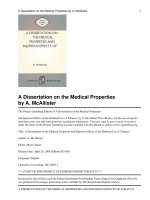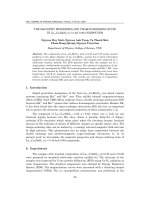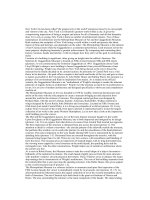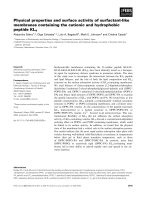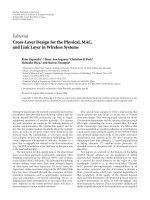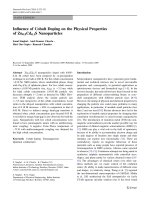Comparison of the physical properties and sealing ability of MTA and portland cement
Bạn đang xem bản rút gọn của tài liệu. Xem và tải ngay bản đầy đủ của tài liệu tại đây (1019.73 KB, 139 trang )
COMPARISON OF THE PHYSICAL PROPERTIES AND SEALING
ABILITY OF MTA AND PORTLAND CEMENT
DR. INTEKHAB ISLAM
B.D.S.
A THESIS SUBMITTED
FOR THE DEGREE OF MASTER OF SCIENCE
DEPARTMENT OF RESTORATIVE DENTISTRY
NATIONAL UNIVERSITY OF SINGAPORE
2005
ACKNOWLEDGEMENTS
I wish to express my sincere gratitude and appreciation to my supervisor Dr. Chng Hui
Kheng for her invaluable guidance and support. It was an honour to be able to work with,
and learn from, her. I thank her and am deeply indebted to her for her patience and
understanding. Without her constant guidance, invaluable advice, discussions and
encouragement none of this would have been possible.
I also wish to thank my co-supervisor Associate Professor Adrian Yap U Jin for his
advice, constant guidance, suggestions and help.
I would also like to extend appreciation and thanks to Mr. Chan Swee Heng, Senior Lab
Officer, for his tireless technical support and advice throughout the two years of my
study. I would also like to express my gratitude to Mr. Lim Choon Teck Edgar,
Department of Civil Engineering, National University of Singapore and the technicians
and laboratory officers in the Department of Civil Engineering for their guidance and
support in running the XRD and Instron.
I would also like to take this opportunity to thank Ms. Agnes Galang, a dear friend, for
taking pains to teach me the basics about Portland cement and also for proof reading my
thesis. I also thank Nyi, Faisal, Vicky, Xiaoyan, Khurram, Baig, Judy, Mui Siang,
Sew Meng, Liu Hua, Chaopeng and all other beloved friends and colleagues, for their
support and encouragement and without whom my research would not have been so
enjoyable.
Finally, I thank my family, specially my parents for their support, love and
encouragement throughout my years of education which made all of this possible. I
dedicate this thesis to my loving wife Chaitali whose patience and support helped me
complete this work.
ii
TABLE OF CONTENTS
LIST OF TABLES
vi
LIST OF FIGURES
vii
SUMMARY
ix
1
CHAPTER 1
1.
INTRODUCTION
1.1
Background
1
1.2
Objectives of Research
3
2
CHAPTER 2
2.
LITERATURE REVIEW
2.1
Introduction
4
2.2
Techniques for assessing sealing ability of endodontic sealing materials
6
2.2.1 Staining technique
2.2.2 Radioactive isotopes
2.2.3 Bacterial metabolites
2.2.4 Liquid pressure technique
2.2.5 Dye penetration
7
8
9
11
12
2.3
Comparison of the leakage behavior of root-end filling materials
14
2.4
Mineral Trioxide Aggregate
17
2.4.1 Physical properties
2.4.2 In vitro leakage studies
2.4.3 Biocompatibility of MTA
2.4.4 PMTA and WMTA
17
18
24
26
Principal component of MTA-Portland Cement
27
2.5.1
28
28
28
31
31
32
33
2.5
2.5.2
2.5.3
2.5.4
2.5.5
Comparison of MTA with Portland cement
2.5.1.1 Composition
2.5.1.2 Biocompatibility
Definition of Portland cement
Composition of Portland cement
Cement production
Cement hydration
`
iii
2.5.6
2.6
2.7
2.9
Types of Portland cement
37
Cement Admixtures
38
2.6.1
2.6.2
2.6.3
2.6.4
2.6.5
2.6.6
38
38
39
39
40
40
Air entraining admixture
Water reducing admixtures
Superplasticising admixtures
Retarding admixtures
Accelerating admixtures
Speciality admixtures
.
X-ray Diffraction Analysis
42
2.7.1
2.7.2
2.7.3
2.7.4
2.7.5
2.7.4
2.7.5
42
42
43
44
44
45
45
Introduction
Braggs law
Powder diffractometers
Identification of solid phases
Reference diffraction Patterns
Sample preparation
Interpretation of data: ASTM method
References
47
CHAPTER 3
3.
Manuscript Prepared for submission to International Endodontic Journal:
X-ray Diffraction Analysis Of MTA And Portland cement
56
3.1
Abstract
57
3.2
Introduction
58
3.3
Materials and methods
60
3.3.1 Sample Preparation
3.3.2 Interpretation of Data
60
60
3.4
Results
62
3.5
Discussion
65
3.6
References
69
iv
CHAPTER 4
4.
Manuscript Draft for Journal of Endodontics: Comparison Of The Physical
And Mechanical Properties Of MTA and Portland Cement
71
4.1
Abstract
72
4.2
Introduction
73
4.3
Materials and Methods
76
4.3.1 pH
76
4.3.2
Radiopacity, Solubility, Setting time, Dimensional change
76
4.3.3
Compressive strength
77
4.4
Results
78
4.5
Discussion
79
4.6
References
82
4.7
Figures and tables for Chapter 4
84
CHAPTER 5
5.
Manuscript Draft for Journal of Endodontics: Comparison Of The Root-end
Sealing Ability Of MTA And Portland Cement
86
5.1
Abstract
87
5.2
Introduction
88
5.3
Materials and Methods
91
5.3.1 Tooth Preparation
91
5.3.2
92
Dye Leakage test
5.4
Results
93
5.5
Discussion
94
5.6
References
97
5.7
Figures and tables for Chapter 5
100
v
CHAPTER 6
6.
Conclusions And Future Recommendations
101
6.1
Conclusions
101
6.2
Future recommendations
101
CHAPTER 7
7.
Appendix
104
vi
LIST OF TABLES
1.
Table
4.1 Summary of the physical properties of the cements
2.
Table
4.2 Summary of the statistical differences for the physical properties
between the groups
84
85
3.
Table
5.1 Depth of dye penetration of the materials
100
4.
Table
5.2 Statistical differences for dye penetration between the groups
100
5.
Table
7.1 pH of the materials as they set
104
6.
Table
7.2 Densitometer readings for Radiopacity determination
106
7.
Table
7.3 Densitometer readings and Aluminum equivalent of the cements
107
8.
Table
7.4 Solubility of the cements
108
9.
Table
7.5 Setting time of the cements
108
10.
Table
7.6 Compressive strength of the cements
109
11.
Table
7.7 Dimensional changes of the cements
110
12.
Table
7.8 Depth of dye penetration
110
13.
Table
7.9 Absorption length and percentage of penetration
111
14.
Table
7.10 Statistical analysis of the pH of the cements when freshly mixed
118
15.
Table
7.11 Statistical analysis of the pH of the cements at thirty minutes
119
16.
Table
7.12 Statistical analysis of the pH of the cements at sixty minutes
120
17.
Table
7.13 Statistical analysis of the solubility of the cements
121
18.
Table
7.14 Statistical analysis of the Initial setting time of the cements
122
19.
Table
7.15 Statistical analysis of the Final setting time of the cements
123
20.
Table
7.16 Statistical analysis of the compressive strength of the
cements at three days
21.
Table
124
7.17 Statistical analysis of the compressive strength of the
cements at 28 days
125
22.
Table
7.18 Statistical analysis of the dimensional change of the cements
126
23.
Table
7.19 Statistical analysis of the Depth of penetration of the cements
127
vii
LIST OF FIGURES
1. Figure 3.1 XRD of WMTA
62
2. Figure 3.2 XRD of PMTA
63
3. Figure 3.3 XRD of WP
63
4. Figure 3.4 XRD of OP
64
5. Figure 4.1 pH of the cements at various time intervals
84
6. Figure 5.1 Typical tooth specimen illustrating depth of dye penetration
100
7. Figure 7.1 Gillmore Apparatus
112
8. Figure 7.2 Solubility of the cements
113
9. Figure 7.3 Initial and Final Setting time of the cements
114
10. Figure 7.4 Compressive strength of the cements
114
11. Figure 7.5 Dimensional changes of the cements
115
12. Figure 7.6 Log plot to calculate Radiopacity of WMTA
116
13. Figure 7.7 Log plot to calculate Radiopacity of PMTA
116
14. Figure 7.8 Log plot to calculate Radiopacity of WP
117
15. Figure 7.9 Log plot to calculate Radiopacity of OP
117
viii
Summary
Mineral Trioxide Aggregate (MTA) has been advocated for use in root-end fillings,
perforation repairs in furcations and roots, direct pulp caps and apexification. In a series
of tests, MTA has demonstrated excellent sealing ability, alkaline pH, biocompatibility
and the ability to promote regeneration of tissue when placed in direct contact with dental
pulp and periradicular tissues. This material has generated interest due to its superior
biocompatibility and physical properties over traditional root-end filling materials. This
led to its rise in popularity as a root-end filling material. However MTA is expensive and
exhibits poor handling characteristics.
MTA is a fine powder consisting of hydrophilic particles of tricalcium silicate, tricalcium
aluminate, tricalcium oxide and silicate oxide. It has been shown that the elements
present in MTA are very similar to those in Portland cement (PC). The physical and
mechanical properties of a material will directly influence its sealing ability. A previous
study has shown PC to be non-toxic and it has been suggested that PC maybe used as a
cheaper alternative to MTA. MTA was first introduced as a grey coloured cement
(ProRoot MTA) (PMTA) which limited its use to areas of no aesthetic concern. To
overcome this disadvantage a tooth coloured version (Tooth coloured formula) (WMTA)
has been introduced. Most tests on MTA have been conducted with PMTA. In contrast,
the number of studies carried out using WMTA is limited.
This study aims to compare the physical properties of WMTA and PMTA, White
Portland cement (WP) and Ordinary Portland Cement (OP) using the International
Standards Organization (ISO), the British Standards Institution (BSI) and the American
ix
Society for Testing and Materials (ASTM) guidelines. The sealing ability of the materials
when used as root-end filling materials were tested with dye leakage tests using
methylene blue dye.
The compressive strength was tested by adapting the methods prescribed by the BSI.
Customized delrin moulds were used to prepare samples of the cements which were
mixed in accordance with the manufacturers’ recommendations. The compressive
strengths of the materials were tested at three days and twenty eight days. All the
materials showed an increase in strength with conditioning and the strength of PMTA
was found to be greater than that of WMTA. OP showed greater strength than WP.
The setting times were evaluated according to the ISO and ASTM specifications, which
requires the measurement of both initial and final setting times using the initial and final
Gillmore needles respectively. All the materials complied with the ISO guidelines.
The radiopacity, solubility, dimensional change was also determined according to the
methods recommended by the ISO and all materials complied with the ISO standards.
X-ray diffraction analysis was carried out on all four cements by using a Powder
Diffractometer. The diffraction patterns were compared to diffraction patterns of known
materials documented in the Powder Diffraction files (PDF). Using the three most
prominent peaks in the diffraction patterns, the constituents of the cements were
ascertained.
x
The major constituents for all the four cements were tricalcium silicate (C3S), tricalcium
aluminate (C3A), calcium silicate (C2S), and tetracalcium aluminoferrite (C4AF). MTA
was found to be very similar to Portland in composition apart from the additional
presence of bismuth oxide in MTA.
In order to compare the sealing ability of the cements when used as root-end filling
materials, dye leakage tests were conducted using methylene blue dye.
Twenty-eight freshly extracted single rooted human premolar teeth with single root
canals were selected. The root canals were prepared using standard instrumentation
techniques. The teeth were obturated with gutta percha and Roth Root Canal Cement
Type 801 (Roth International Ltd., Chicago, IL). The teeth were divided into four groups
of six teeth each. The teeth were filled as follows: Group 1: PMTA, Group 2: WMTA,
Group 3: WP, Group 4: OP. Two teeth served as positive controls while two teeth served
as negative controls.
The teeth were then immersed in methylene blue dye for seventy-two hours and then
assessed for dye leakage by longitudinally splitting the teeth. The depth of dye
penetration was measured and expressed as a percentage of the length of the retrofilling.
Teeth that exhibited leakage beyond the retrofilling material were branded as
unacceptable. Data was analyzed using ANOVA and Fisher’s LSD (p<0.05). The mean
depth of dye penetration was 62.72% for WMTA, 54.25% for PMTA, 62.06% for WP
and 53.80% for OP cement. WMTA showed significantly greater dye penetration than
both PMTA and OP cement while WP showed significantly greater dye penetration than
PMTA and OP cements. There was no significant difference between PMTA and OP and
xi
between WMTA and WP cements. None of the teeth in any of the groups showed leakage
beyond the retrofillings. All the four cements effective sealed the root canal. The control
groups adequately demonstrated validity of the test procedure.
PC and MTA were found to be very similar in their sealing ability and physical
properties. Their constituents were also found to be very similar. Given the low cost of
PC and similar properties when compared to MTA, it is reasonable to consider PC as a
possible substitute for MTA in endodontic applications. Methods to improve its setting
time to enable its use as a restorative material should also be explored. The primary
disadvantage of MTA seems to be its poor handling characteristics. An improvement in
the handling characteristics may lead to expanded clinical use and should also be
explored. Further in vitro and in vivo tests, especially with regards its biocompatibility,
should be conducted to explore the use of Portland cement as an alternative to MTA.
xii
Chapter 1
Introduction
1.1 Background
The choice of a root-end filling material is one of the many factors that influence the
success of root-end surgery. Numerous materials including amalgam, Zinc-oxide eugenol
based cements such as Super EBA, IRM, composite resins and glass ionomer cements
have been used (1). The main disadvantages of these materials include microleakage,
varying degrees of toxicity and sensitivity to the presence of moisture.
The emergence of Mineral Trioxide Aggregate (MTA) as a root-end filling material has
generated a lot of interest due to its ability to effectively seal the pathways of
communication between the root canal system and the external surfaces of the tooth.
MTA is a fine hydrophilic material which sets in the presence of moisture in slightly less
than three hours. It consists of tricalcium silicate, tricalcium aluminate, tricalcium oxide
and silicon oxide with bismuth oxide added to increase its radiopacity (2).
A number of in vitro and in vivo experiments have been done to compare the sealing
ability and biocompatibility of MTA with amalgam, Super-EBA and IRM. In a series of
tests, MTA has demonstrated excellent sealing ability (3), alkaline pH, biocompatibility
and ability to promote regeneration of tissues when placed in contact with dental pulp and
periradicular tissues (4). MTA has been shown to demonstrate superior sealing ability
and biocompatibility in comparison to conventional root-end filling materials. This led to
a rise in its popularity as a root-end filling material. MTA has been used experimentally
-1-
for root-end filling in dogs and monkeys (5, 6), direct pulp caps in monkeys (7), and
perforation repairs in dogs (8). MTA has also been successfully used in humans for
perforation repairs (9) and in the management of teeth with open apices (10).
MTA is currently available commercially in two formulations, ProRoot MTA (PMTA)
(Dentsply Tulsa Dental, Tulsa, OK), a grey variety and ProRoot MTA (Tooth Coloured
Formula) (WMTA) (Dentsply Tulsa Dental, Tulsa, OK). The United States Patent No
5,415,547 and 5,769,638 for MTA states that the base material for MTA is Portland
cement (PC) and bismuth oxide has been added to make the mix radiopaque (11, 12).
This has generated interest in the evaluation of PC as an alternative to MTA and recent
studies have compared MTA with PC. These studies have shown that MTA and PC have
almost identical properties macroscopically, microscopically and when analyzed using Xray diffraction analysis. They have been shown to be very similar in composition except
for the presence of bismuth in MTA (13).
Abdullah et al. have also shown PC to be non toxic and it has been suggested that it may
be used as a restorative material (14).
The physical and mechanical properties of a material will directly influence its sealing
ability. Although several studies have examined the sealing ability and biocompatibility
of MTA, there are a very limited number of studies which examined the physical
properties and none of these had examined the physical properties of WMTA. Studies
comparing the physical properties and sealing ability of MTA and PC are still not
available.
-2-
1.2 Objectives of research
In order to ascertain whether Portland cement can be used as a substitute for MTA, its
major constituents, physical characteristics, sealing ability and biocompatibility need to
be assessed. Although the biocompatibility has been studied, studies comparing the major
constituents, physical properties and sealing ability are still not available. The physical
properties of a material will determine if the material is suitable for use as a restorative
material and dictate its eventual clinical applications. The objectives of this research
were:
1. To compare the major constituents present in White MTA, ProRoot MTA, White
Portland cement and Ordinary Portland cement using XRD analysis.
2. To compare the physical properties (pH, solubility, setting time, radiopacity,
dimensional change) of White MTA, ProRoot MTA, White Portland Cement and
Ordinary Portland cement.
3. To compare the compressive strength of White MTA, ProRoot MTA, White
Portland cement and Ordinary Portland cement.
4. To compare the in vitro sealing ability of White MTA, ProRoot MTA, White
Portland cement and Ordinary Portland cement.
-3-
Chapter 2
LITERATURE REVIEW
2.1 Introduction
The main purpose of performing periradicular surgery is to remove a portion of the root
with undebrided canal space or to seal the canal when a complete seal cannot be
accomplished through a coronal approach. The indications include complex root canal
anatomy, irretrievable materials in the root canal, procedural accidents requiring surgery,
persistent symptomatic cases, refractory lesions and biopsy. Apicoectomy with retrograde
or root-end filling is a widely accepted procedure in endodontics when all attempts at
conventional or orthograde procedures have failed (15). The degree of success following
root canal therapy has been reported to be as high as 98.7% (16) and as low as 45 % (17).
Weine (18) has reported that the majority of non-surgical endodontic procedures which
fail do so because of inadequate apical seal. The preferred treatment of failing endodontic
cases is non-surgical retreatment. However, a non-surgical approach may not be possible
because of physical barriers (anatomical, post and core restorations, broken instruments
etc.) and patient intolerance. Surgical therapy then becomes the preferred alternative. The
procedure involves exposing the involved apex, resecting the root-end, preparing a class I
cavity and inserting a root-end filling.
The purpose of root-end fillings is to establish a seal between the root canal space and the
periapical tissues. According to Gartner and Dorn (19), a suitable root-end filling material
should be (a) biocompatible, (b) adapt well to the walls of the root canal system, (c) non-
-4-
toxic, (d) not susceptible to the presence of moisture, (e) insoluble in oral fluids, (f) non
resorbable and dimensionally stable, (g) capable of long term sealing of all margins of the
retropreparation, (h) capable of inducing osteogenesis and cementogenesis, (i) easy to
prepare and use, (j) sterilizable, (k) radiographically visible, (l) readily available and (m)
inexpensive.
There have been major advances in surgical technique over the years. Newer root-end
filling materials with improved stability and biocompatibility accompanied these
advances but a material fulfilling all these requirements is yet to be found.
Numerous materials have been suggested for use as root-end fillings including guttapercha, amalgam, Cavit, Intermediate Restorative Material (IRM), polycarboxylate
cements, Super EBA, glass ionomer cements, composite resins, Zinc Phosphate cements,
Zinc oxide-eugenol cements and MTA (20).
The suitability of these materials has been tested by evaluating their microleakage
(bacterial penetration, radioisotope, dye and fluid penetration), marginal adaptation,
cytotoxicity, physical and mechanical properties and in vivo testing in experimental
animals and humans.
-5-
2.2 Techniques for assessing sealing ability of endodontic filling materials
Different techniques have been used to evaluate the sealing ability of various endodontic
filling materials.
The basic principle involves the assessment of the penetration of a tracer along the
obturated root canal of an extracted human tooth. An extracted tooth is prepared and
obturated and then the tooth is exposed to a tracer to facilitate the assessment of a
possible penetration of liquid between the canal wall and the material. Dyes,
radioisotopes and bacterial products have been used as tracers (21). A root canal sealer or
cement in conjunction with a solid core material such as gutta percha is the most common
material used to obturate the root canal system.
The International Organization for Standardization (ISO) has outlined specific
requirements for root canal sealers. In 1986, the ISO published the first edition of an
International Standard for permanent obturation of the root canal with or without the aid
of obturating points. The standard was revised and currently ISO 6786:2001 is available
which lays down specifications for Dental root canal sealing materials (22). However, the
standard does not include requirements for root-end filling materials.
Obturation techniques and filling materials can be tested in vivo for sealing ability.
However, such studies require long observation periods and patient compliance and are
therefore difficult to conduct. Various in vitro methods have been used to evaluate the
-6-
sealing ability of different obturating materials and techniques. Most of these methods are
based on the assessment of microleakage along the obturated root canal.
Usually a root canal in an extracted tooth is obturated with the filling material to be
tested. Then the tooth is immersed in a solution containing a tracer and penetration of the
tracer between the root canal walls and the material or into the material itself is assessed
(21).
Various tracers such as dyes, radioactive isotopes, bacteria, and bacterial metabolic
products have been used. In most cases dyes in water solutions have been used, but it has
been argued that the small size of the tracer molecule may not be a valid indicator (23,
24).
Larger tracer molecules such as human serum albumin (25, 26), starch (27) and Poly R
dye (28) have also been used but it has been suggested that it is better to use a smaller
tracer molecule to assess the apical seal. It was argued that materials which prevent the
leakage of smaller tracer molecules would also prevent the leakage of larger ones (29).
2.2.1 Staining Technique
Hovland and Dumsha (30) developed a silver staining technique to assess the apical
leakage of root canal sealers. They coated the obturated teeth with nail varnish except
around the apical foramen and placed the teeth into a 50% solution of silver nitrate for 2
hours. Then they rinsed and sectioned the teeth and examined them under a
-7-
stereomicroscope to demonstrate a dark area of silver precipitation where leakage had
occurred.
Magura et al. (31) studied the penetration of whole human saliva by staining sections
with hematoxylin and eosin. They kept obturated teeth in saliva for 90 days, constantly
replacing the old saliva with fresh saliva everyday. Then the teeth were prepared for
histological examination. Salivary penetration along the obturated root canal was
measured by the extent of deep basophilic staining of the adjacent dentine in the
hematoxylin and eosin stained section.
2.2.2 Radioactive Isotopes
Leakage studies with radioactive isotopes as tracers have been used in vitro in a manner
similar to dyes. After removal of the root canal from the radioactive isotope solution, the
roots are sectioned longitudinally and then placed on dental radiographs to produce auto
radiographs (32).
Various isotopes have been used and it was shown in a comparative study that
35
S was
superior to 131I, 86Rb, 22Na, 32P and 45Ca. 35S not only penetrated better than the others but
also produced the sharpest and most detailed auto radiographs. Matloff et al. (32) also
evaluated various tracer molecules. The purpose of their study was to compare several
methods that had been used to assess marginal leakage of root canal fillings. Teeth were
exposed to solutions containing methylene blue dye,
45
calcium,
14
carbon labelled urea,
and 125iodine labelled albumin for 48 hours to compare the degree of leakage indicated by
-8-
each technique.
14
Carbon labelled urea penetrated further than the
albumin. The difference was attributed to exchange of the
45
Ca or
125
I labelled
45
Ca with calcium in the
apatite mineral surrounding the root canal, and the larger size of the albumin molecule.
Methylene blue dye was found to penetrate further up the canal than any of the isotope
tracers.
Assessment techniques which determine the length of time required for leakage to occur
have also been studied. The radioactive tracer is placed into the root canal space after
removing the coronal two thirds of the root filling material. The tooth is then suspended
in a solution of saline or human serum albumin. At selected time intervals samples of the
solution are withdrawn and assessed for radioactivity as an indication of leakage (33).
Experiments using
14
C Glucose as the tracer have also been carried out using similar
protocol as the above (34). An external radionuclide detection technique for the
evaluation of the apical seal has also been described (35). The apical leakage was
measured using an external detection technique after submerging the root apices in a
solution containing the radioisotope
99
Tc. A gamma camera was used to detect the
radiation from the teeth.
2.2.3 Bacterial metabolites
It has been suggested that in endodontic leakage studies, assessment of penetration of
microorganism may be a more biologically significant approach in comparison to dye or
isotope penetration (36).
-9-
Goldman et al. (24) described a test method where latex tubing was secured over
obturated roots with ligature wire and filled with a broth containing acid forming
bacteria. The roots were then placed in tubes containing a phenol red broth which would
change colour to yellow if bacteria reached it by penetrating the obturating material. They
emphasized that using bacteria instead of smaller molecular dyes reduced the chances of
false readings in testing for leakage of hydrophilic materials. In another study, Wu et al.
(37) determined the convective transport of water from the coronal to the apical end of
obturated root canals by the movement of an air bubble in a capillary glass tube
connected to the apex of the experimental root section using a headspace pressure of 120
kPa. Water transport through existing voids in the obturated canals could be measured
reproducibly this way. The root canals were first exposed to a small motile bacterium,
Pseudomonas aeruginosa, growing in a reservoir at the coronal end of each root. After 50
days, two specimens allowed penetration of bacteria to a reservoir at the apical end. All
the roots were then assessed quantitatively for convective transport of water. Their
findings indicated that fluid transport occurs through obturated root canals, most of which
do not allow the passage of bacteria.
Bacterial metabolites such as butyric acid have also been used. Kersten et al. (38)
mounted obturated roots in the middle of tubes which were fixed at both ends with rubber
membrane stoppers. They filled the coronal reservoir with butyric acid which was the
leakage marker substance and the apical reservoir with valeric acid. The tubes were then
centrifuged or thermocycled. Samples were taken from the apical reservoir at different
time intervals and tested for presence of butyric acid by gas chromatography. The authors
concluded that the method could determine the volume of leakage without modifying the
- 10 -
roots or the root fillings. In another similar experiment, endotoxin was used as a tracer
along with butyric acid and methylene blue dye (39). The authors tested for endotoxin
with a limulus lysate test, for butyric acid with gas-chromatography and for methylene
blue with spectrophotometric analysis. They found that leakage of bacteria-sized particles
and large-sized protein molecules could be prevented only when both sealer and pressure
were used in obturating root canals with gutta-percha. They also found that leakage of
butyric acid was comparable with leakage of methylene blue.
2.2.4 Liquid pressure technique
Pashley et al. (40) developed the liquid pressure technique for measuring dentine
permeability and it permitted quantitative measurements over time. The method was later
adapted to evaluate the seal of endodontic materials. Yoshimura et al. (41) showed that
the experimental system could reliably measure microleakage in retrograde amalgam
fillings. They sealed stainless steel tubing to the apical root canal orifice and then
connected the tubing to a micropipette and a microsyringe to a pressure reservoir
containing phosphate buffered saline. They measured the movement of an air bubble in
the micropipette to quantify the flow of saline.
- 11 -
2.2.5 Dye penetration
In most instances tracers have been dyes in water solutions. It represents a simple and
inexpensive technique and is still one of the most popular techniques.
Dye penetration technique was first used by Grossman (1939) and it has been popular
ever since. Earlier glass tubes were used and later bovine and extracted teeth were also
used (21).
The root canal is first instrumented and after obturation the tooth is usually stored for
some time to allow complete setting of the filling materials. Then the entire root canal
area, except the area surrounding the apex, is coated with nail enamel to prevent dye
leakage via the root surface and then the root is immersed in a dye for various time
intervals. After the tooth is removed from the dye, the nail enamel is removed and the
tooth prepared for assessment of dye penetration.
The teeth may be sectioned longitudinally and linear dye penetration may be measured
(42, 43) or they may be cut perpendicular to the long axis producing a series of cross
sections which are then tested for the presence of dye (42).
The most popular dye used is methylene blue. The first to use this dye was Stewart (44)
who immersed root filled teeth in methylene blue dye for up to six weeks to study their
leakage.
- 12 -
The advantages of methylene blue dye are that it penetrates the water compartment of the
tooth, does not react with the hard tissues and is readily detected under visible light (32,
42, 44).
Methylene blue has been shown to produce better leakage behaviour than
calcium chloride,
14
C-labelled urea and
45
Ca labelled
125
I-labelled albumin. Teeth were instrumented,
filled in a standardized manner and exposed to solutions containing methylene blue dye,
calcium-45, carbon-14-labelled urea, and iodine-125-labelled albumin for 48 hours to
compare the degree of leakage indicated by each technique. Methylene blue dye was
found to penetrate further up the canal than any of the isotope tracers. Carbon-14-labelled
urea penetrated further than the calcium-45- or iodine-125-labelled albumin (32).
Apart from methylene blue, other dyes used include aniline dye (45), Prussian blue dye
(46), Procion B blue dye (47), Indian ink (48), Pelikan ink (49), crystal violet dye (50),
Rhodamine B dye (51), Procion B green dye (52) and eosin dye (53).
The time of immersion varies from one day (30) to six months (45) but it has generally
been within 3 days to a week. Dye penetration may be enhanced by negative or positive
pressure (54), or by working in a vacuum chamber (55).
- 13 -
